| Botanical Name |
|
| Family |
Fabaceae - The legume and pod-bearing family. (Pea & Bean Family) |
| Pronunciation |
|
| Common Name(s) |
English: Cape laburnum; Wild laburnum
Afrikaans: Geelkeurboom; Kaapse Geelkeur
IsiXhosa: inDloli; umSitshana
IsiZulu: umKhiphampethu; inSiphane-enkulu
|
| Plant Group |
- Tree A woody, self-supporting perennial plant usually with a single main stem and generally growing more than 6 meters tall.
|
| Plant Size |
- Very Small
| Tree | 3m to 4m |
| Shrub | 25cm to 50cm |
| Perennial/ground cover | Up to 10cm |
| Bulb | 10cm to 20cm |
| Succulent | Up to 5cm |
|
| Position |
- Light or Dappled Shade Found below trees with sparse, open foliage. Ideal for the protection of herbaceous plants.
- Partial Shade The area is in shade for part of the day and in full sun for part of the day.
- Sun The area is in full sun for all or most of the day, all year round.
|
| General Information |
- Drought Tolerance: Moderate The plant is moderately adapted to arid conditions and can survive short periods of drought and high temperatures without extra water.
- Evergreen Plants that have leaves all year round.
- Frost: Half-hardy The plant is able to survive low temperatures and some frost but requires protection against severe frost.
- Roots Non-invasive Safe to plant near pools, paving, walls or buildings.
- Water Moderate These plants will need some extra watering compared to water-wise plants. Plant them together, in at least some shade and in a convenient proximity to the house so that grey water can be utilised during times of drought.
|
| Specific Information |
The fresh light green leaves of Calpurnia aurea are graceful and drooping. The flowers are especially enticing to carpenter bees. This species flowers when still young. Prune lightly to shape after flowering to keep it bushy, small and to increase flowering. Protect young plants from frost. The specimen in my garden is situated in the teeth of the wind and is reasonably wind resistant, but a few stems do break off in very strong winds.
|
| Ad Break |
|
| Flowers |
| Description |
pea-flower, hanging in bunches of stems with up to 30 flowers
|
| Season |
- Summer Plants will seldom bloom for the entire season as given in the list, but should flower during a period within these parameters.
|
| Colour |
|
| Growth Rate |
- Fast Specifying growth rate can be very misleading as there is considerable variation of growth rate depending on type and species of plant, available water, supplementary feeding, mulching and general care, as well as the plants suitability and adaptability to the garden environment.
|
| Plant Uses |
- Attracts bees, butterflies or other insects This plant attracts insects which can be food for birds or other creatures in your garden.
- Attracts Birds This plant will attract birds.
- Border A strip of ground, at the edge of a driveway or path in which ornamental plants or shrubs are planted.
- Boundary A plant useful for planting around the edges of the property to form a green or colourful backdrop, an impenetrable hedge, to hide walls or create privacy.
- Container Trees, shrubs and ornamental species that can adapt to growing in a restricted environment.
- Filler Either a fast growing tree or shrub used temporarily to fill in an area while the permanent plants grow to a desired size, or a plant used to fill gaps in borders or beds.
- Pioneer for new gardens A very fast growing plant, able to withstand hardship, that can be used to populate land that has recently been cleared of natural vegetation. These plants pave the way for slower-growing species by adding nutrients to the soil and creating leaf litter.
- Provides light / dappled shade A tree with an open to sparse canopy, through which varying degrees of sunlight can penetrate.
- Rock Garden An area constructed of larger rocks, arranged naturally, to emphasise the use of stones as a main element. Generally plants used do not need a lot of care.
- Suitable for smaller gardens Such plants do not have invasive root systems, remain small or controllable and can often be grown in containers.
- Water Features These plants may have dramatic, lush foliage or graceful form. They do not shed excessive leaves and do not have invasive root systems.
- Wild Garden An indigenous garden planted for the benefit of wildlife and birds. Provides food, water, a variety of mini-biomes and no poisonous chemicals are used.
|
| Distribution and Habitat |
Eastern Cape, KwaZulu-Natal and Swaziland, to Mpumalanga, Gauteng and Limpopo, northwards into tropical Africa to Ethiopia, and southern India, in forests, on forest margins and in clearings, on hill sides, on the edges of woody kloofs and in bushveld.
|
| Planting Suggestions |
|
| Medicinal Uses |
South Africa: used to destroy lice and maggots, relieve itches and to treat allergic rashes. East Africa: leaf sap is used to destroy maggots in wounds. Nigeria: the seeds are used to treat abscesses. Ethiopia: it is used to treat stomach complaints, headache, eye diseases, amoebic dysentery, scabies and as an insecticide. The wood is heavy and hard but not much used.
|
| Ad Break |
|


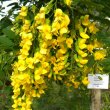
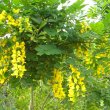
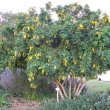
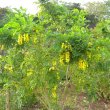
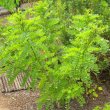
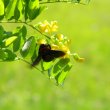
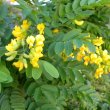


Comments
Calpurnea Aurea
How do you cultivate this tree? 3 have come up in my garden. Did birds perhaps bring the seeds to my garden? How do I go about planting them out?
Thank you for your answer.
Calpurnea aurea seedlings
Hi P. J.
How they got into your garden is a bit of a mystery as the seeds are not eaten by any birds that I know of.
I am curious as to how you were recognised the seedlings - have they flowered already and how big are they? It is difficult to make transplanting suggestions without knowing the size of the plants. Please send me a couple of photos if you can or more information information as to the size and where you are situated.
Kind regards
Lorraine
Have one growing in my veggie garden
Hi - I have 1 growing in the soil of my veggie garden. I had planted some onion seeds directly in the bag of soil laying flat on the ground. During the summer an interesting plant emerged and I allowed it to grow to see what it would be. Late summer (central Florida) it bloomed with the pretty yellow flowers, and then in September the green pods emerged. It is still in that same bag of soil. I really like the plant. How can I successfully transplant it? It is about 4 1/2 foot tall, thriving in one bag of soil!
I would also like to grow more of these from the seed pods. Any tips you can share? I live in zone 9. The photo was taken in August before the yellow flowers emerged.
Thank you!
Ummm
Hi Carra
My apologies for having taken so long to reply to your comment.
Are you quite sure you have uploaded the correct image? The plant in your image has absolutely no resemblance to the tree described above.
Kind regards
Lorraine
Discuss this plant
Share knowledge, ask a question or give an experience.